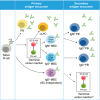Memory B cell heterogeneity: Remembrance of things past
- PMID: 29345369
- PMCID: PMC6200418
- DOI: 10.1002/JLB.4MR0517-215R
Memory B cell heterogeneity: Remembrance of things past
Abstract
B cells that persist for long periods of time after antigen encounter exist as either antibody-producing plasma cells (long-lived plasma cells, LLPCs) that reside primarily in the bone marrow or rapidly responsive memory B cells (MBCs) that reside in the spleen and circulation. Although LLPCs are thought to be non-responsive to a secondary infection, MBCs respond to subsequent infection through the production of antibody-secreting cells, formation of new germinal centers (GCs), and repopulation of the memory pool. Dogma suggests that MBCs express class-switched, somatically hypermutated BCRs after undergoing a GC reaction. Yet this narrow view of MBCs has been challenged over the years and it is now well recognized that diverse MBC subsets exist in both rodents and humans. Here, we review current thoughts on the phenotypic and functional characteristics of MBCs, focusing on a population of somatically hypermutated, high affinity IgM+ MBCs that are rapidly responsive to a secondary malaria infection.
Keywords: IgM; T-dependent; antibody; germinal center; memory B cells.
©2018 Society for Leukocyte Biology.
Figures


Similar articles
-
Somatically Hypermutated Plasmodium-Specific IgM(+) Memory B Cells Are Rapid, Plastic, Early Responders upon Malaria Rechallenge.Immunity. 2016 Aug 16;45(2):402-14. doi: 10.1016/j.immuni.2016.06.014. Epub 2016 Jul 26. Immunity. 2016. PMID: 27473412 Free PMC article.
-
IgM+ and IgM- memory B cells represent heterogeneous populations capable of producing class-switched antibodies and germinal center B cells upon rechallenge with P. yoelii.J Leukoc Biol. 2022 Nov;112(5):1115-1135. doi: 10.1002/JLB.4A0921-523R. Epub 2022 Jun 3. J Leukoc Biol. 2022. PMID: 35657097 Free PMC article.
-
A Temporal Switch in the Germinal Center Determines Differential Output of Memory B and Plasma Cells.Immunity. 2016 Jan 19;44(1):116-130. doi: 10.1016/j.immuni.2015.12.004. Epub 2016 Jan 12. Immunity. 2016. PMID: 26795247 Free PMC article.
-
Multiple routes to B-cell memory.Int Immunol. 2012 Jul;24(7):403-8. doi: 10.1093/intimm/dxs050. Epub 2012 Mar 26. Int Immunol. 2012. PMID: 22451529 Review.
-
Plasticity and heterogeneity in the generation of memory B cells and long-lived plasma cells: the influence of germinal center interactions and dynamics.J Immunol. 2010 Sep 15;185(6):3117-25. doi: 10.4049/jimmunol.1001155. J Immunol. 2010. PMID: 20814029 Review.
Cited by
-
Systems biology of malaria explored with nonhuman primates.Malar J. 2022 Jun 7;21(1):177. doi: 10.1186/s12936-022-04199-2. Malar J. 2022. PMID: 35672852 Free PMC article. Review.
-
B cell intrinsic expression of IFNλ receptor suppresses the acute humoral immune response to experimental blood-stage malaria.Virulence. 2020 Dec;11(1):594-606. doi: 10.1080/21505594.2020.1768329. Virulence. 2020. PMID: 32407154 Free PMC article.
-
Conserved Epigenetic Programming and Enhanced Heme Metabolism Drive Memory B Cell Reactivation.J Immunol. 2021 Apr 1;206(7):1493-1504. doi: 10.4049/jimmunol.2000551. Epub 2021 Feb 24. J Immunol. 2021. PMID: 33627377 Free PMC article.
-
Plasmodium falciparum-specific IgM B cells dominate in children, expand with malaria, and produce functional IgM.J Exp Med. 2021 Apr 5;218(4):e20200901. doi: 10.1084/jem.20200901. J Exp Med. 2021. PMID: 33661303 Free PMC article.
-
Brg1 Supports B Cell Proliferation and Germinal Center Formation Through Enhancer Activation.Front Immunol. 2021 Sep 1;12:705848. doi: 10.3389/fimmu.2021.705848. eCollection 2021. Front Immunol. 2021. PMID: 34539636 Free PMC article.
References
Publication types
MeSH terms
Substances
Grants and funding
LinkOut - more resources
Full Text Sources
Other Literature Sources
Medical
Miscellaneous

